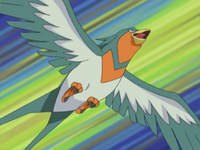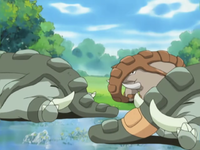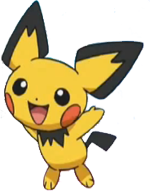Shiny Pokémon
Alternate coloration (Japanese: 色違い alternately colored) of a Pokémon is one of the many differences that a Pokémon can have within its species. Commonly, this is called being a shiny (Japanese: 光る shining) Pokémon due to the sparkling sound effect made at the start of an encounter with one in the games.
Shiny Pokémon in the games may differ in color from their normal counterparts either very little or very much. Usually the former is the case, with some Pokémon, such as Froslass, having their shiny form be only a few shades lighter in color. However, many Pokémon will have a spectacular difference between their normal and shiny variations; even extremely common Pokémon like Caterpie show a dramatic difference. An evolutionary line is not necessarily guaranteed to have similar alternate colourations, even if their standard colourations remain consistent; both Ponyta and Rapidash have orange flames, but an alternate coloured Ponyta has blue flames, while an alternate coloured Rapidash has grey flames.
Despite being completely different colors, however, the two forms of Shellos and Gastrodon are not normal/shiny variations of one another. Their difference is more akin to the difference between Unown or Spinda.
Also, if a Pokémon is first encountered with an alternate colour, then the Pokédex will have the normal counterpart's colour.
To distinguish the Pokémon from their normally colored counterparts, many fans refer to alternate-colored Pokémon as their color, such as a green Espeon or a gold Steelix.
In the games
In the main series, alternate coloration was introduced in Generation II. This was likely to take fullest advantage of the Game Boy Color, which enhanced Gold and Silver and was required for Pokémon Crystal.
When a shiny Pokémon appears in the wild or from a Trainer's Poké Ball, stars will surround it and make a pinging sound effect. In Generation II, this ping happens before the Pokémon's cry, while in Generations III and IV, it occurs afterward. In Pokémon Battle Revolution, a flash of light circles the Pokémon upon its release from the Poké Ball. On the Pokémon's status screen, its shiny status is indicated in Generation II as three small stars beside its gender and in Generations III and IV as a large star. In Generation III, the Pokémon's Pokédex number will also be colored gold instead of black, and in Generation IV, the number will be colored red.
Pokémon Stadium
In Pokémon Stadium and Pokémon Stadium 2, Pokémon with a nickname can be colored slightly differently, whether or not they are actually alternate colored. This seems to have been removed from later games.
Generation II

In Generation II, shininess is determined by the individual values (IVs) of a Pokémon. If a Pokémon's Speed, Defense, and Special IVs are 10, and its Attack IV is 2, 3, 6, 7, 10, 11, 14 or 15, it will be shiny. This determination allowed for compatibility with Generation I, as if a shiny Pokémon is traded back, then traded forward, it would retain its shininess. Despite the bonus of backward compatibility allowing for a shiny Pokémon to learn Generation I TMs, provided it was a Generation I Pokémon, shiny Pokémon are only slightly above average in terms of IVs.
Due to the probability of the IVs lining up in any of these manners to produce a shiny Pokémon, the chance of obtaining one in Generation II is approximately 1/8192. However, if one breeds a shiny Pokémon properly, the offspring may have as high as a 1/64 chance of being shiny, depending on the species of Pokémon.
To highlight alternate coloration, a red Gyarados at the Lake of Rage is part of the main plot of the Generation II games. After its defeat or capture, a Red Scale will be obtained, which can be given to Mr. Pokémon in exchange for an Exp. Share. The red Gyarados is the only Pokémon in the games that will be shiny without fail.
Shininess is inherent to an individual Pokémon; that is, a Pokémon that starts out shiny will always be shiny, and one that is not will never be (provided its data is unaltered). Upon evolution, a Pokémon will retain its shiny status. A shiny Charmander, if leveled up, will eventually become a shiny Charmeleon and then a shiny Charizard, just as a regular Charmander will become a regular Charmeleon and then a regular Charizard. This is due to the status being determined by values inherent to the Pokémon; however, there is a difference in the determination between II and Generations III to IV.
Generations III and IV
In Generation III, most of the data structures were redone. As such, a Pokémon's shininess would no longer need to be linked to its stats due to incompatibilities between the previous generations. The determinant for shininess is instead a calculation based on the Trainer ID number of the player encountering it and the personality value of the Pokémon. The same method is used in Generation IV.
The secret ID and Trainer ID bytewords are first xored together, and then the first byteword of the personality value is xored with the second byteword of the personality value. If the xor of these two results is less than eight, then the Pokémon is shiny. This results in a probability of 8 in 65536; simplified as 1/8192 (2-13, or approximately 0.012207%), just as in Generation II. Symbolically:
(Trainer ID) xor (Secret ID) = E
(First byteword of personality value) xor (Second byteword of personality value) = F
If E xor F is less than eight, then the Pokémon is shiny.
In the Trainer Tower in Pokémon FireRed and LeafGreen there are three Trainers which have shiny Pokémon. In the single battle mode, the seventh Trainer has a shiny Meowth, while in double battle mode, the first pair of Trainers have a shiny Espeon. In another series of battles, a Trainer will send out a shiny Seaking.
In Generation IV, some Pokémon, such as Mystery Gifts and Ranger Manaphy, can't be shiny due to the game's code. However, the Ranger Manaphy's shininess won't be altered by the game if traded to a second cartridge as an egg (changing the ID and SID). There are other methods which make obtaining alternately colored Pokémon a little bit easier: the Masuda method and the PokéRadar slightly raise the probabilities of hatching Pokémon from eggs and catching Pokémon from the wild, respectively.
Pokémon Mystery Dungeon
It is sometimes thought that the TM Merchant in the first Pokémon Mystery Dungeon is a shiny Pokémon. It is a Kecleon, and although Kecleon are normally green, it is actually purple, including its sprite. However, though it is alternate-colored (like the Kecleon in The Kecleon Caper), it is not shiny (shiny Kecleon have a blue stripe instead of a red stripe) and is more likely a different color due to its Color Change ability. It says that it was so excited about Orbs that it turned rosy-colored.
Pokémon Mystery Dungeon 2
In Pokémon Mystery Dungeon 2, a shiny Celebi appears, although shiny Pokémon are not obtainable normally in the game. Some argue that due to an altered timeline, this particular Celebi is shiny. Others argue that this one has feelings for a male Pokémon. It is shown when the player talks with Celebi at the relay point in the Deep Dusk Forest, where Celebi blushes when trying to deny her feelings for Grovyle. Therefore, the shiny coloring (pink) further emphasizes that this particular Celebi is inherently female. Grovyle also refers to this Celebi as 'she' and 'her'. Also, Dialga appears in different coloration. Like the purple Kecleon, this Dialga is not shiny. Unlike Kecleon, however, this is caused by a collapsing Temporal Tower, resulting in complete loss of self-control, which earns it the name of "Primal Dialga".
Super Smash Bros.
In the Super Smash Bros. series, Mewtwo, Squirtle, Ivysaur, Charizard and Lucario each have several different colorations exclusive to the series. One of Pikachu's alternate colorations is its shiny form wearing Red's hat; however, all other playable Pokémon in the series, except Mewtwo, do not have their shiny form as an alternate coloration.
In the TCG
Alternate colored Pokémon have appeared in the TCG as well, first as Shining Pokémon in Neo Revelation and Neo Destiny, and later as Pokémon ![]() in EX Team Rocket Returns - EX Power Keepers. Intense Fight in the Destroyed Sky includes three cards with alternate coloration artwork and a holofoil effect, but are not classified as rare cards. Unlike Shining Pokémon and Pokémon
in EX Team Rocket Returns - EX Power Keepers. Intense Fight in the Destroyed Sky includes three cards with alternate coloration artwork and a holofoil effect, but are not classified as rare cards. Unlike Shining Pokémon and Pokémon ![]() , these newest alternate coloration cards do not play significantly differently from their normal coloration counterparts, and since the names of the cards are not changed to indicate the alternate coloration, they can be evolved into Stage 1 Pokémon.
, these newest alternate coloration cards do not play significantly differently from their normal coloration counterparts, and since the names of the cards are not changed to indicate the alternate coloration, they can be evolved into Stage 1 Pokémon.
In the anime
Although the games had not premiered alternate colored Pokémon until Generation II, several Pokémon seen beforehand were colored differently. One such example is the pink Butterfree, the mate of Ash's Butterfree, which appeared as early as the twenty-first episode. This is, however, not the standard alternate coloration for a Butterfree, causing many to not count it. Likewise, the first appearance of a Generation III Pokémon in The Kecleon Caper featured a non-standard alternate colored Pokémon, this time a purple Kecleon.
The first Pokémon with an alternate coloration that was seen was also the first Generation II Pokémon to appear, a Ho-Oh in the first episode. Because alternate coloration was not yet an explored concept, however, most do not consider this to be a shiny Pokémon either. A blue Breloom and a light-blue Marill also appeared in Weekend Warrior, which aren't the official alternate colors for those Pokémon, and are possibly coloring errors.
In the Orange Archipelago, certain Pokémon have a different coloration because the climate is different than that of the mainland. For example, a Butterfree would have gold wings with red spots on them instead of just being white.
The first true shiny Pokémon that appeared, however, was a Noctowl in Fowl Play!. Ash eventually captured it, and, as in the games, sparkles surround it as it comes from its Poké Ball. Several other shiny Pokémon have appeared later as well.





